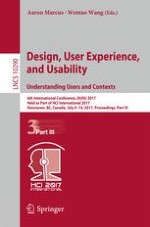2017 | OriginalPaper | Buchkapitel
Taiwanese People’s Wayfinding Personas and Tool Preferences
verfasst von : Chih-Wei Joy Lo, Chia-Ning Liao, I-Ping Chen, Tsuei-Ju Hsieh
Erschienen in: Design, User Experience, and Usability: Understanding Users and Contexts
Aktivieren Sie unsere intelligente Suche, um passende Fachinhalte oder Patente zu finden.
Wählen Sie Textabschnitte aus um mit Künstlicher Intelligenz passenden Patente zu finden. powered by
Markieren Sie Textabschnitte, um KI-gestützt weitere passende Inhalte zu finden. powered by
